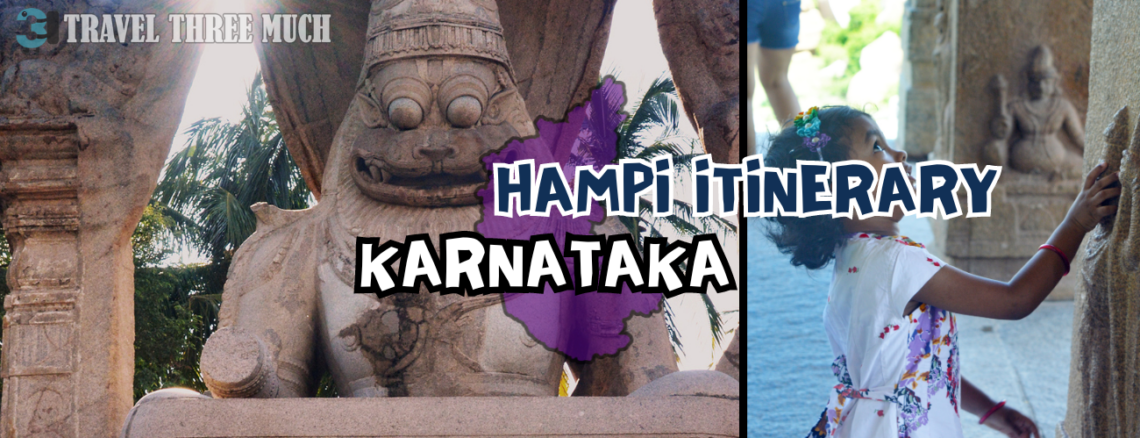
Hampi Itinerary – Day 1 of 4
You can see the magnificent Hampi in your own way. Some choose to hire an auto rickshaw, some take their car and some of us do it with a hired bike or on foot.
We visited Hampi in the October of 2018. We took an overnight bus from Chennai to Hospet and then an autorickshaw from Hospet to our B&B in Hampi. It was a modest and clean homestay with a view of the Virupaksha temple from its balcony. It was perfect for us because many places were accessible by foot.
Day 1 of our trip was completely on foot. We decided to get acquainted with the town and hence explored all the places slowly.

Kadlekalu & Sasivekalu Ganesha
After a bath and lunch at the B&B, we set out to explore the first place of the day – the monolithic Kadlekalu Ganesha.

The name comes from the similarity between the god’s generously proportioned belly and unsplit Bengal gram.

The deity resides in a simple enclosed sanctum and was completely visible only because of the midday sun. The deity has the standard accessories of the four-armed version – a half-broken tusk, a goad, a noose and a modak in a bowl.
Next was the Sasivekalu Ganesha who sits atop a hill in an open sanctum with the roof supported by pillars.

The views from this hill of the Virupaksha temple tower are memerising.
Hemakuta Hill and it’s Temples
We started our exploration of the Hemakuta hill and its group of temples.

The path that leads you to the temple has many rocks and boulders with rock cut images of a reclining Vishnu, lingams, a scene from the Ramayana with Hanuman, Rama, Lakshmana and Sita, and so on.

The path leads to a two-tiered pavilion that is a testament to the art and engineering that flourished under the Vijayanagara empire.
A short trek through a gateway on the hill brings you to a Shiva temple with a pavilion that has shrines facing east, west and north.


While the Shiva temple was beautiful, while we were walking up to it, we saw this small shrine. I don’t know why, but we really loved it.
There was an unknown sense of calmness and we spent quite some time there.

There are also some half-completed mantapas which have the plinth and pillars but no roof.
Krishna Temple Complex
Descending from the Hemakuta hill through the same path, we made our way to the Krishna temple complex that is further down the road. Before we visited the temple, we stopped at the temple tank called the pushkarini for a short breather.
The stepped tank has on both the sides closest to the entrance pavilion, walkways which have roofs supported by two colonnades each on either side.

The walkway on the right side has a small hall at the center with small decorative brick structures on the top. At the center of the tank is a small four columned structure. Just outside the pushkarini is another colonnaded walkway called the Krishna Bazar, which used to be a market complex.
We visited the temple next but as the inner sanctum was under maintenance, we could only take a stroll around the outer sanctum.

Lakshmi Narasimha temple
Next, we proceeded down the road which led us through a pillared gateway. There in the midst of paddy fields, we saw the Lakshmi Narasimha temple. Seated in the temple is a monolithic statue of Lakshmi Narasimha, one of the iconic symbols of Hampi.
Even to this day, the image of Lord Narasimha emerging from amidst the coconut trees is fresh in our memory. Truly a sight to behold!
The deity is seated on a bed of coils of the Adhisesha, the seven-headed guardian snake of Vishnu. The hoods of the serpent serve as a canopy for the deity. The deity’s four arms and the statue of Lakshmi which would’ve once been seated on the left side are now missing.
Our little one was so mesmerized by this place, its history and the story of the war between the kings. For a long time after our trip, she asked us to narrate the story every day. There were times she would suddenly ask me “What was the name of that king who built the Narasimha statue?”

Near this temple is one more monolithic Shivalinga called the Badavalinga, reputed to have been commissioned by a poor woman. The Shivalinga has the three eyes carved as a line drawing. The atmosphere of the setting sun that lit the deity and the neighbouring Badavalinga temple in its gentle light set a peaceful tone for the close of the first day.
We made our way back to the B&B with a short detour through the Hampi Bazar – a marketplace complex that has two-tiered structures at some places and a colonnaded walkway at other places similar to the one at Krishna Bazar.
Map for the day
It was such a fulfilling day which came to a close with a magical sunset view.





